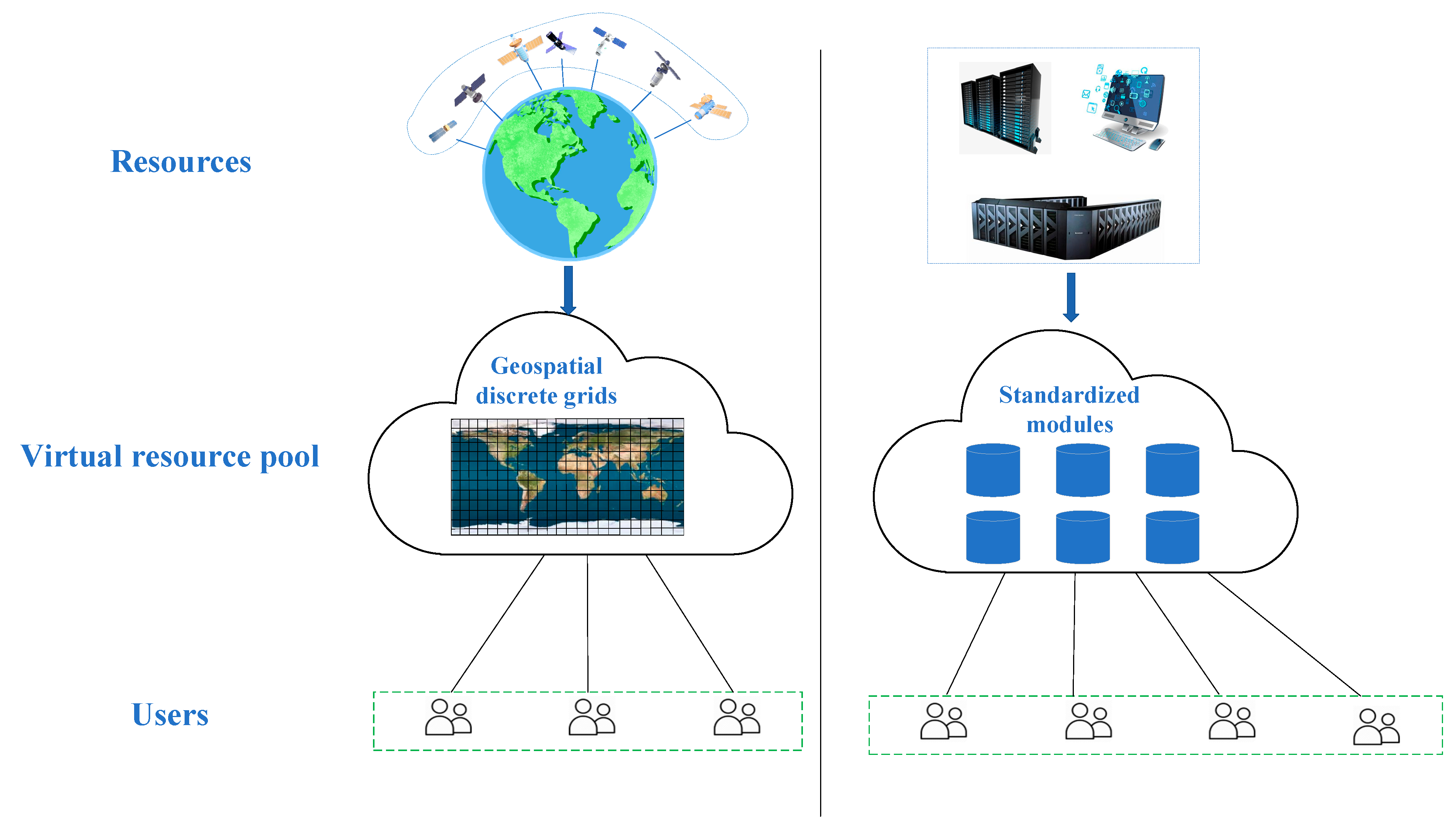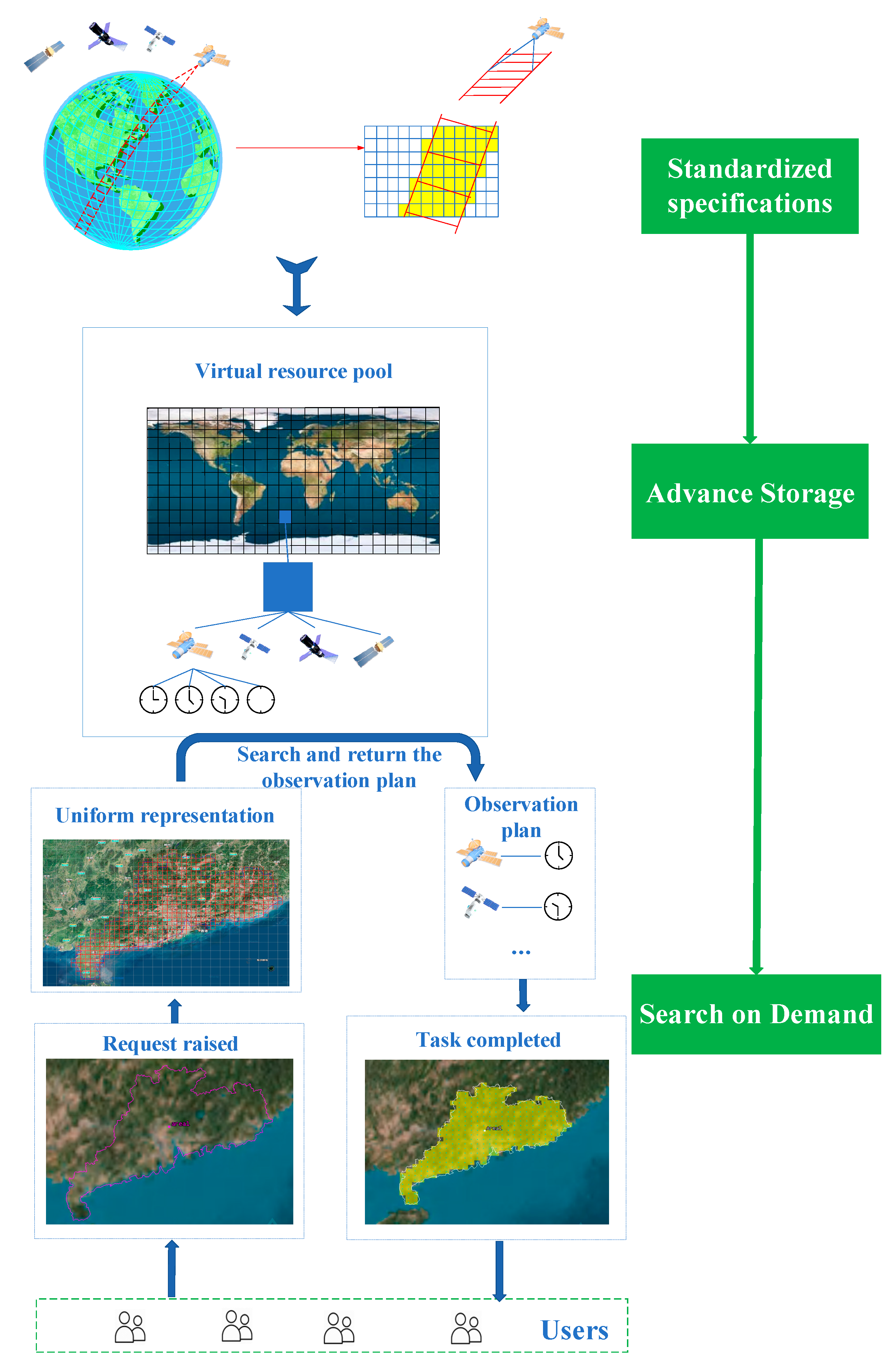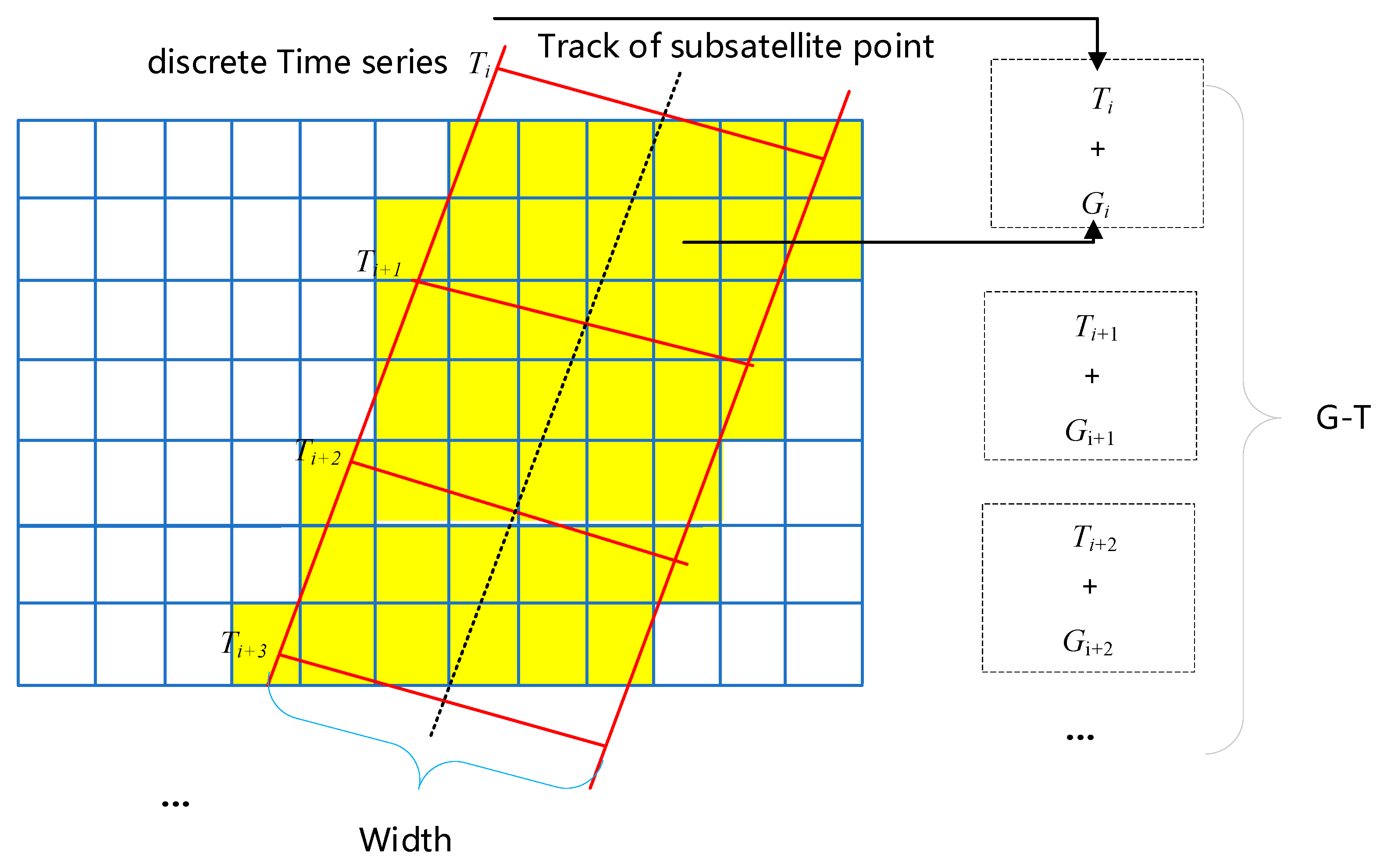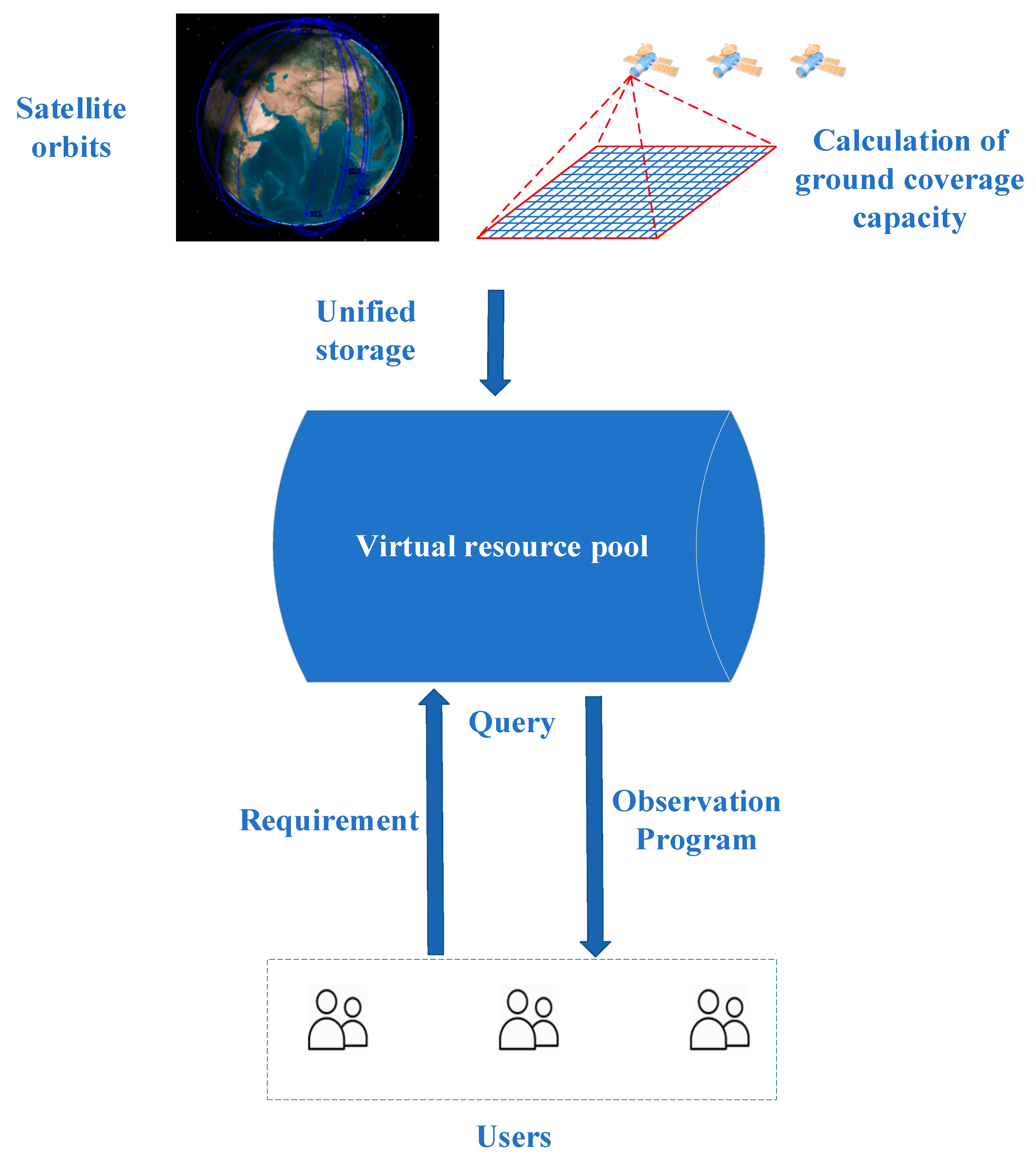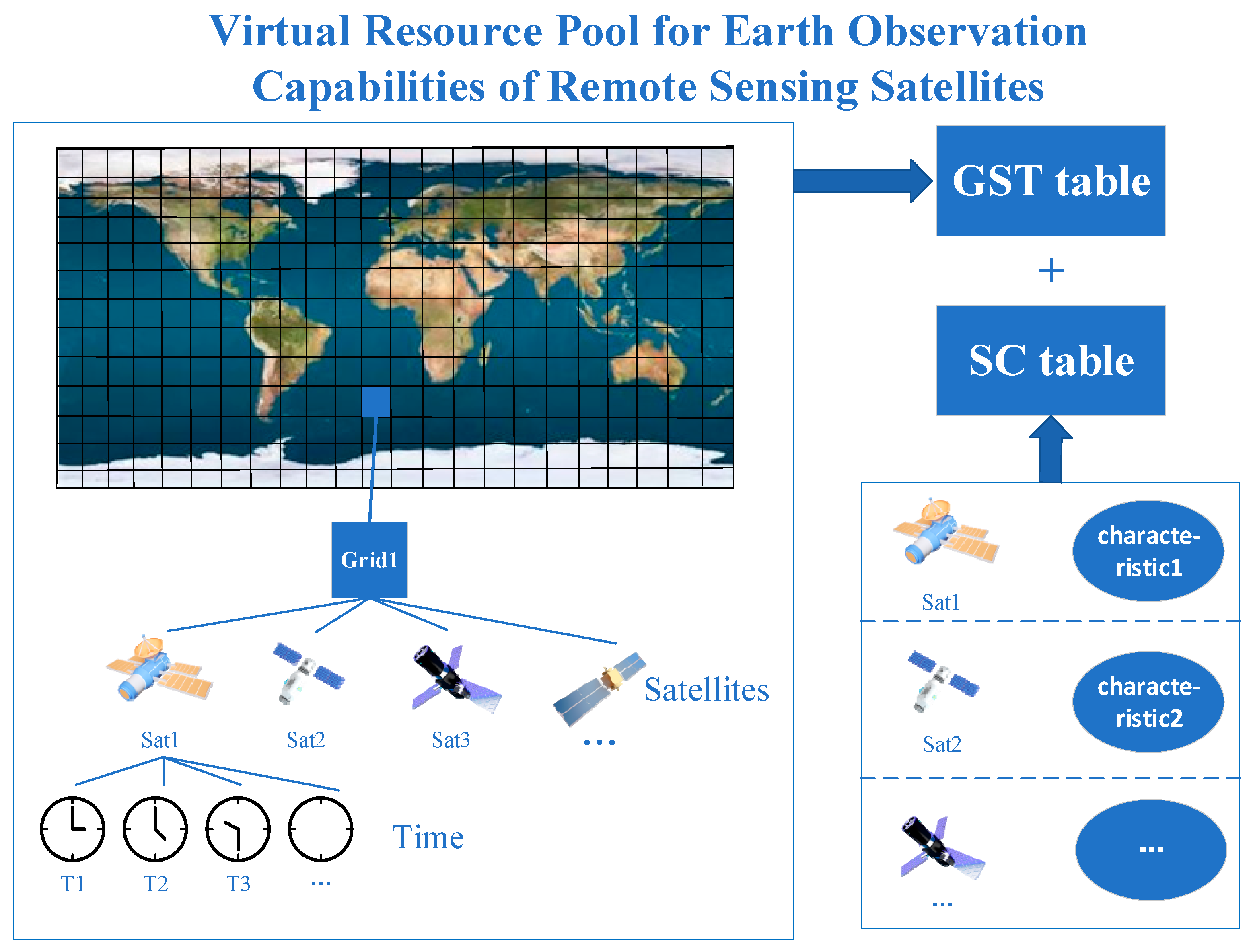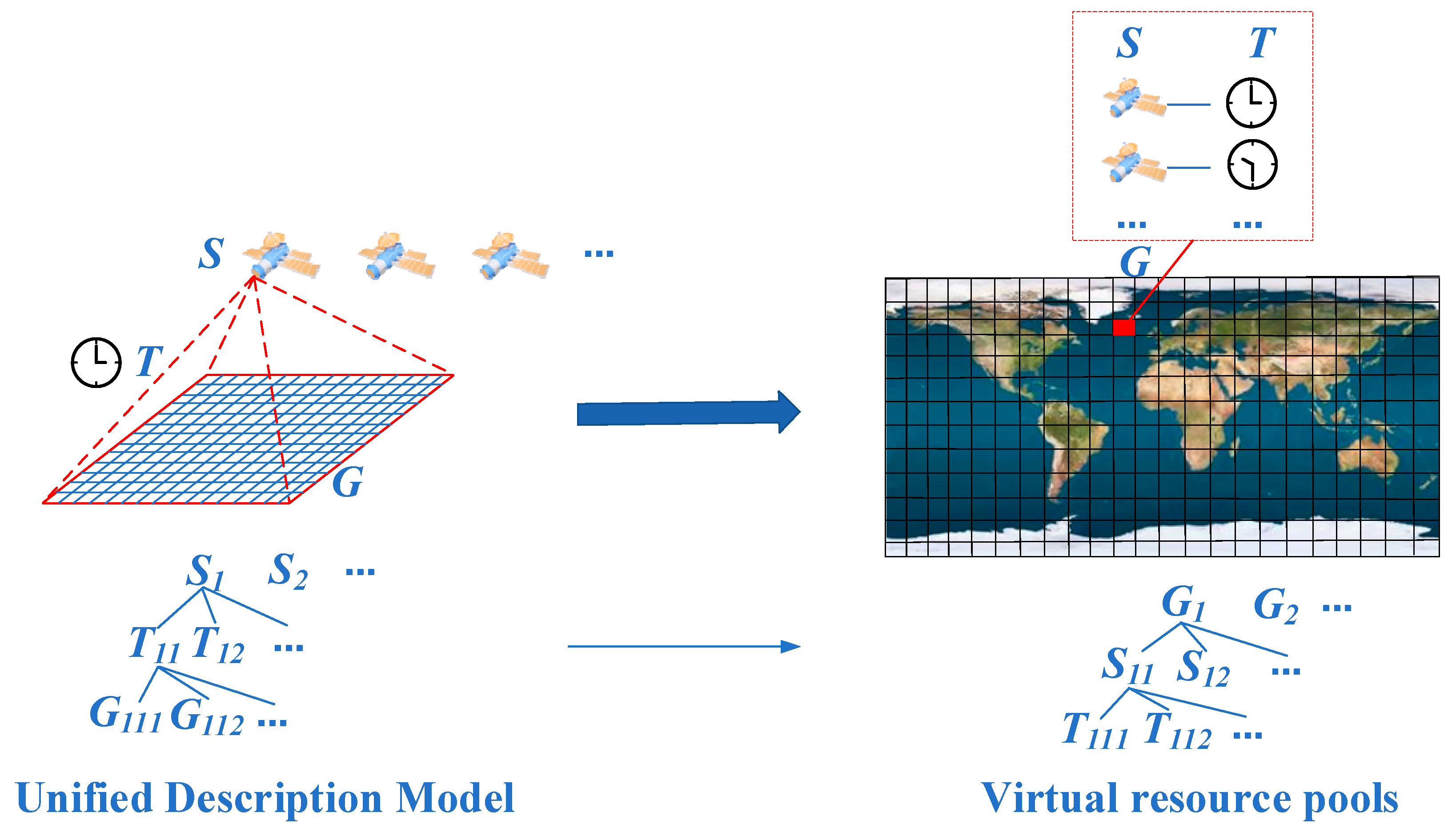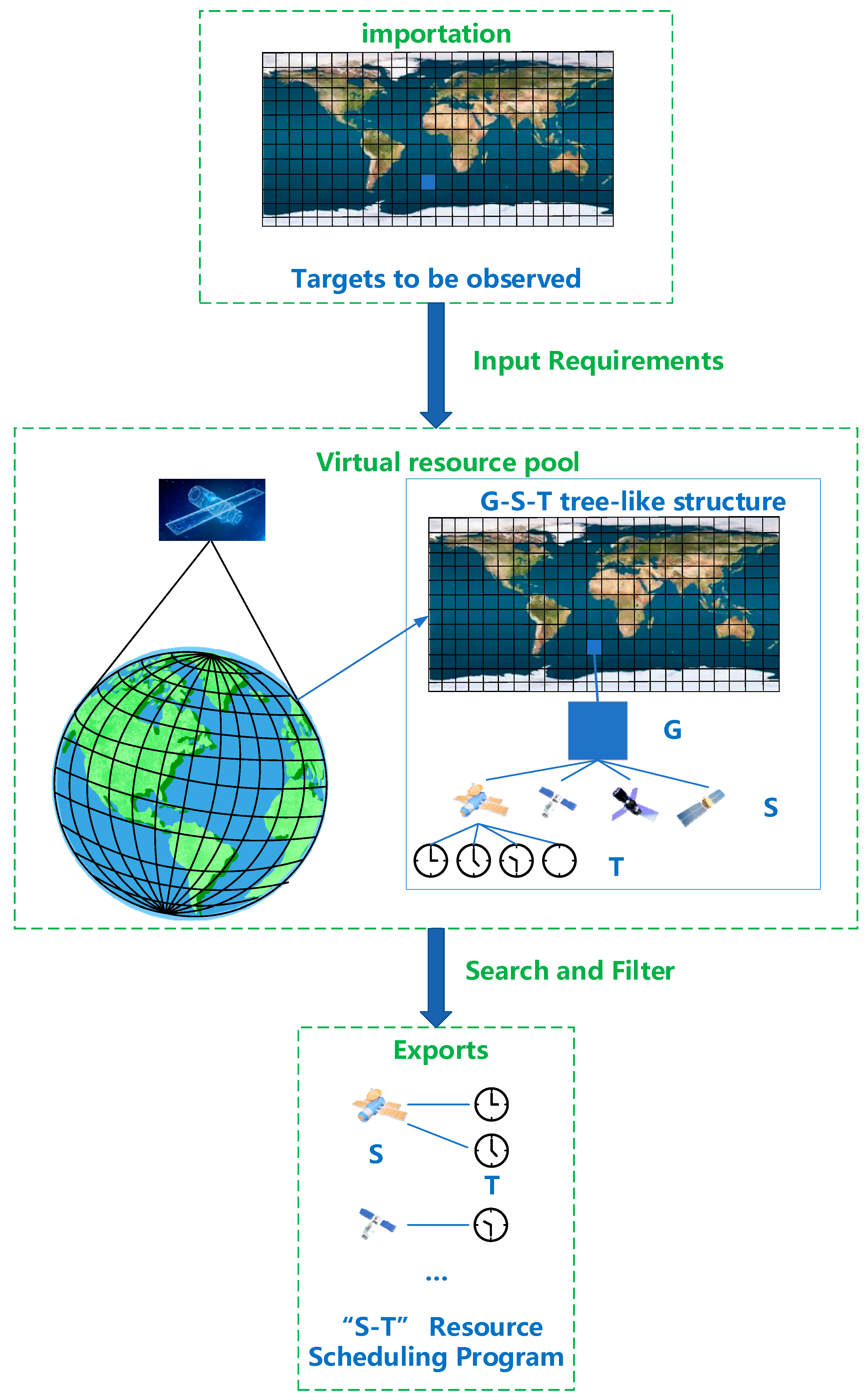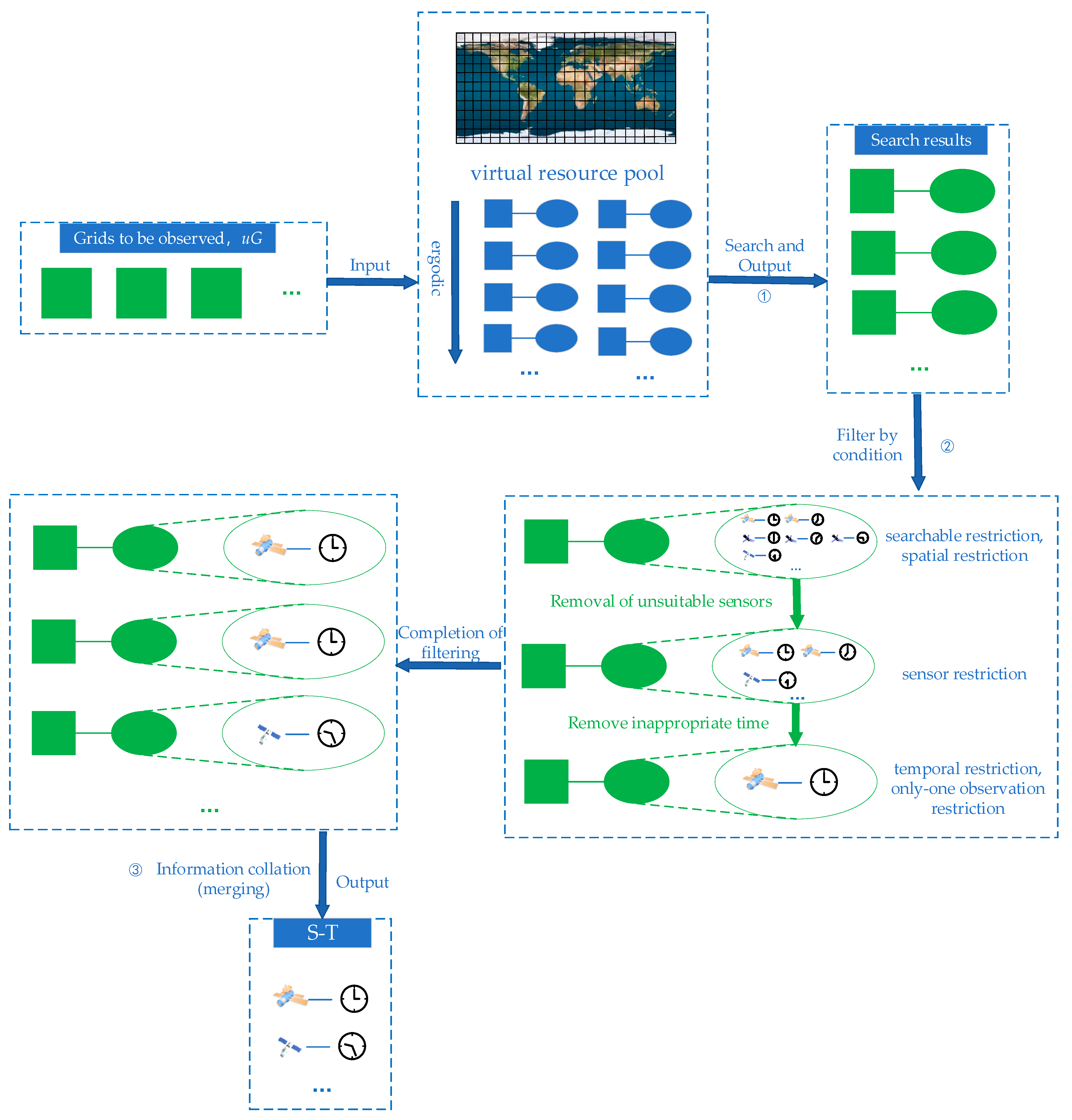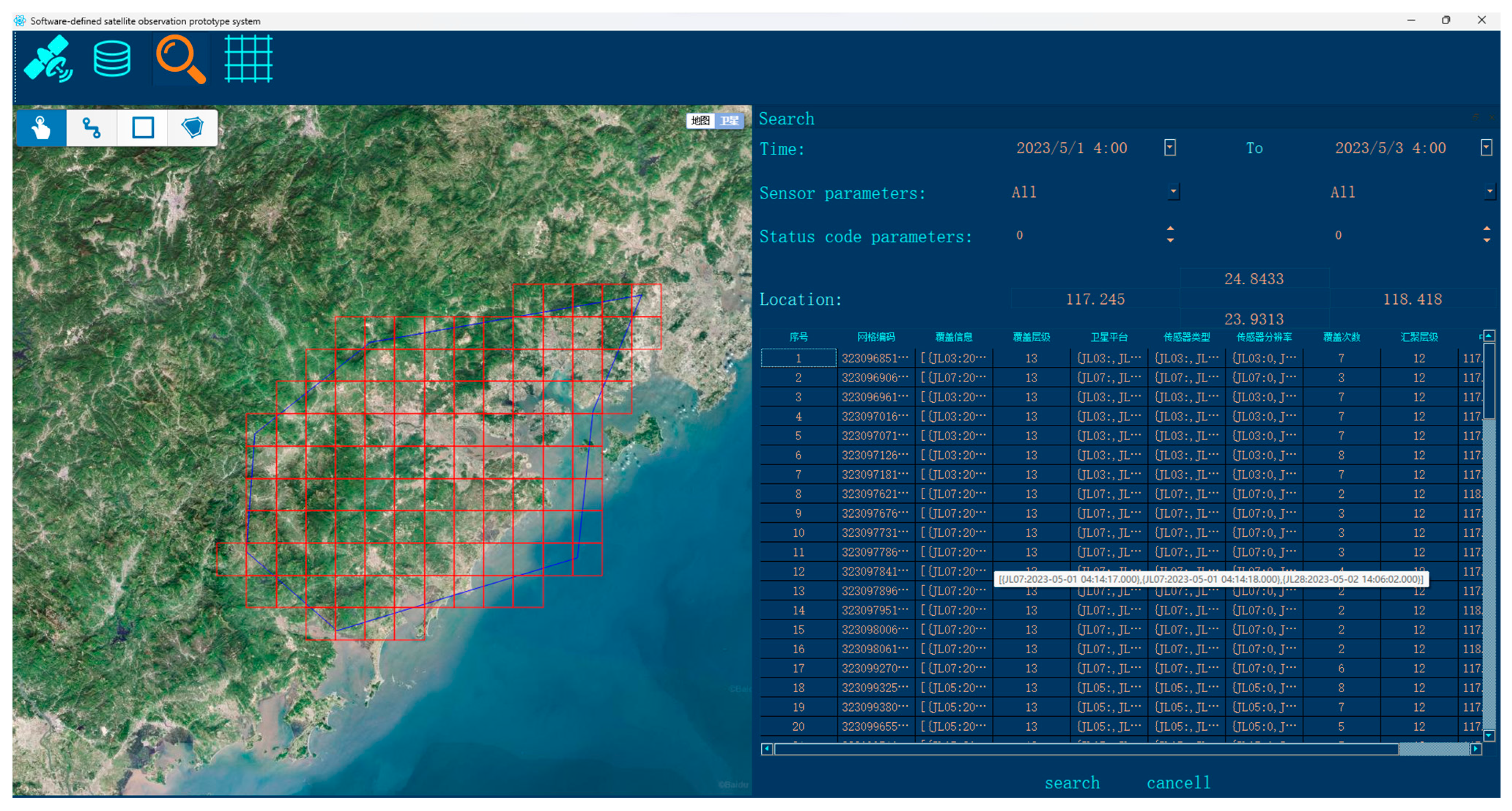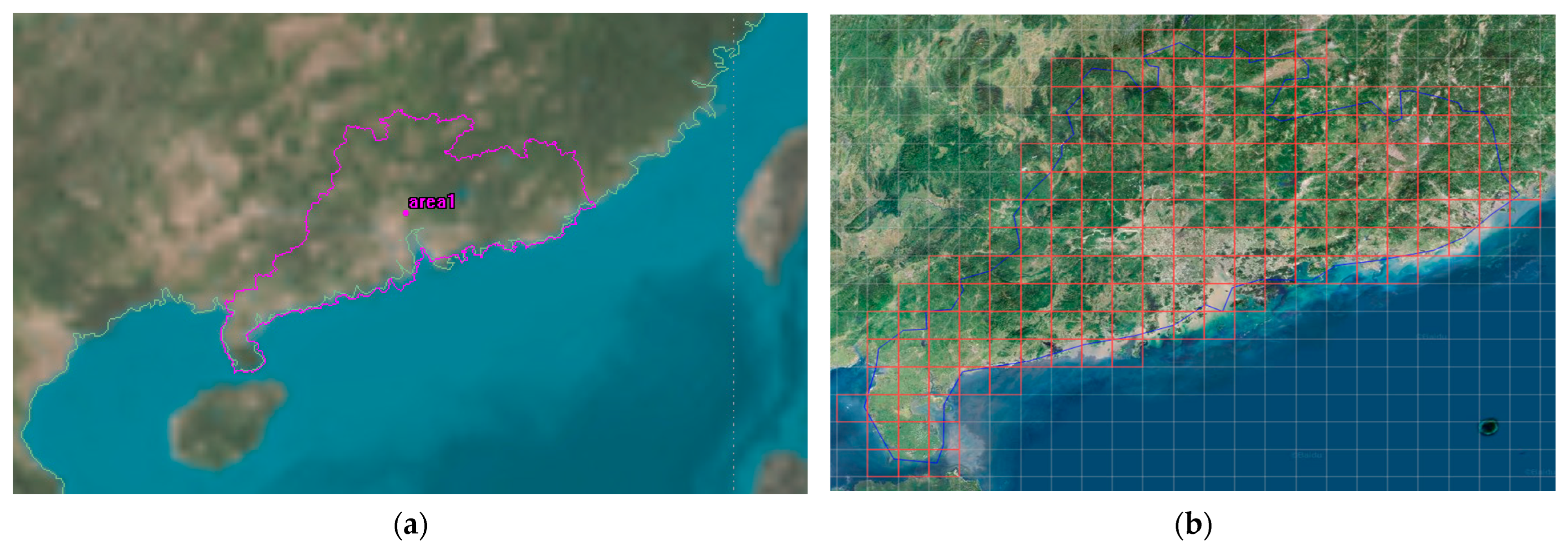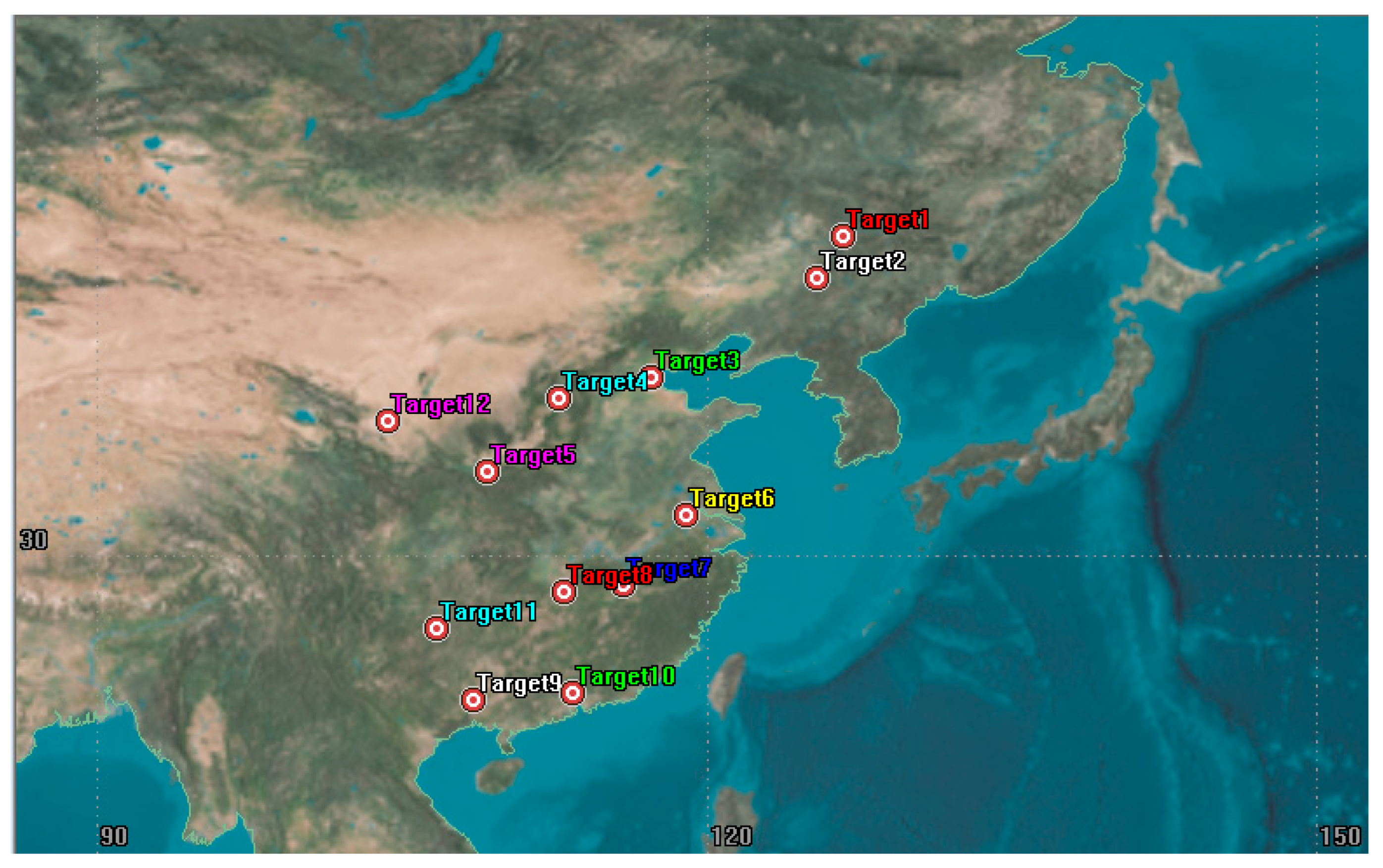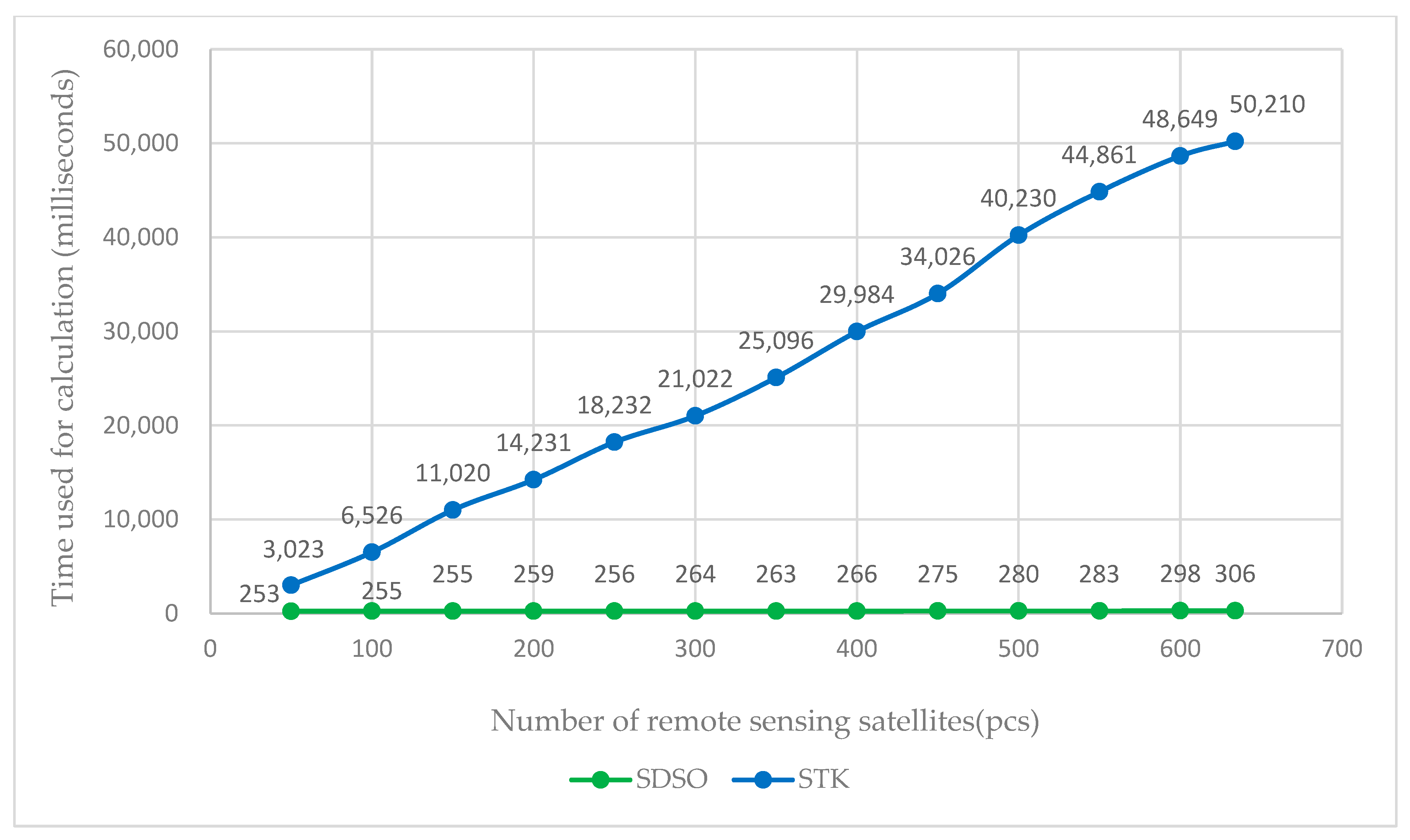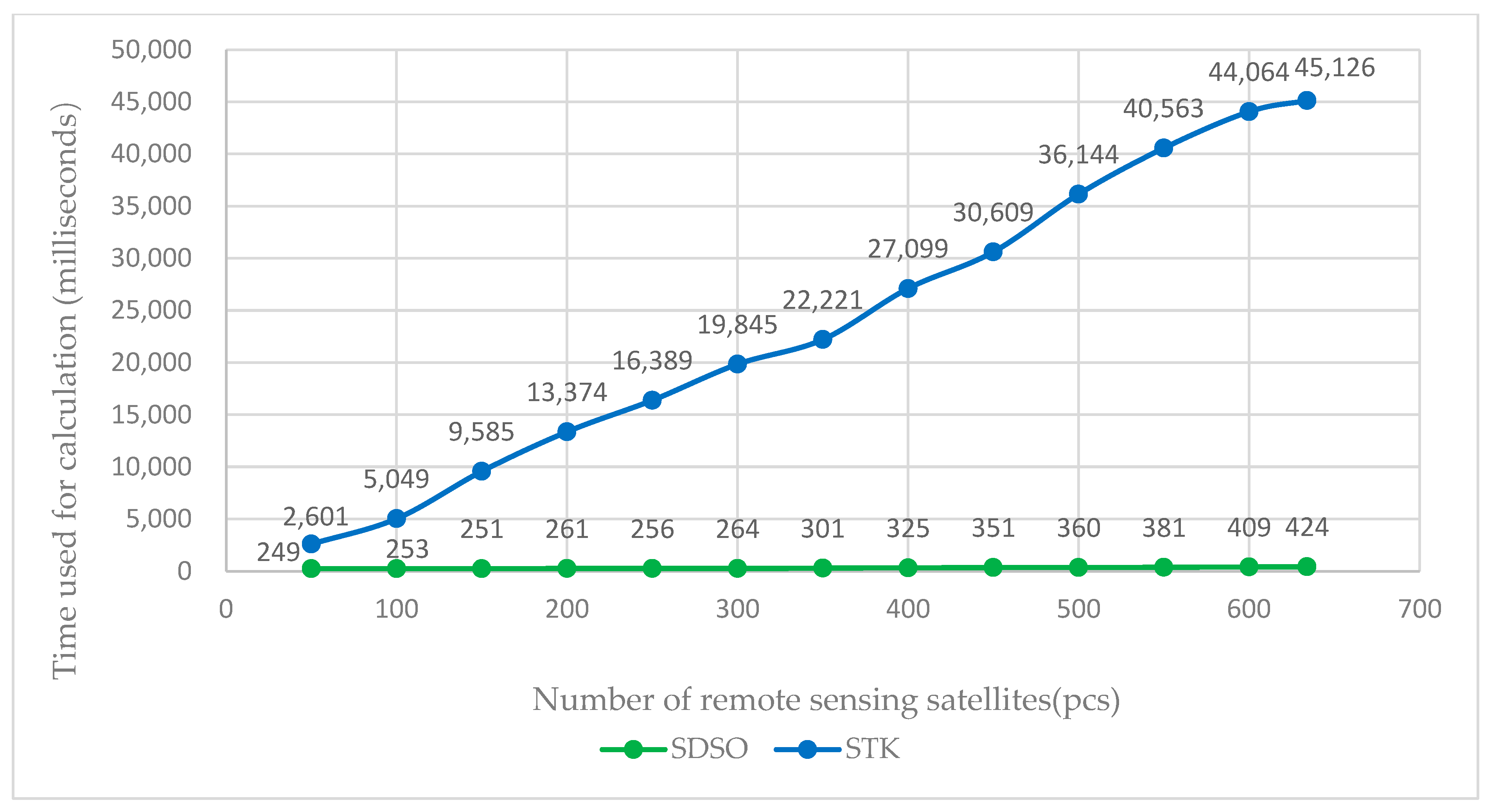1.1. Background and Current State of Research
A remote sensing satellite is a kind of artificial Earth satellite that observes ground, sea, or air targets in its orbit and obtains target information through its payload such as on-board photoelectric remote sensing devices. The classic type of remote sensing satellite uses imaging equipment, such as visible light cameras, infrared cameras, or synthetic aperture radar to acquire images of specified targets on the ground according to the needs of business users. Due to their unique advantages, including their long operation time, wide observation range, lack of airspace and national boundary restrictions, and lack of personnel safety issues, remote sensing satellites have been widely applied to battlefield situational monitoring, land resource surveys, agricultural yield estimation, marine environment monitoring, urban land use planning, natural disaster forecasting, and disaster assessment. Consequently, a large number of remote sensing satellites have been launched, constructing satellite constellations. A constellation usually consists of several satellites configured according to certain rules. Remote sensing satellite constellations can achieve continuous monitoring of an area of Earth’s surface at any time. They play a significant role in improving the timeliness and integrity of satellite data for Earth observation and more complex application scenarios. Hence, the construction of remote sensing satellite constellations is valued by many countries. With the rapidly increasing demands of space exploration, the number of remote sensing satellites has increased dramatically in recent years. According to the existing known satellite launch and networking plans, this proliferation trend will be maintained long into the future. The number of remote sensing satellites is bound to reach thousands in orders of magnitude. In addition, several well-established giant constellations of low-orbit artificial satellites such as Starlink and OneWeb, which contain huge numbers of satellites, have already emerged. Theoretically, if remote sensors are attached to a giant constellation with thousands of satellites, it will become a giant remote sensing satellite constellation. At present, in remote sensing technology application fields such as military applications and disaster monitoring, which have very strict requirements for immediacy, the current remote sensing satellite observation resource scheduling system cannot yet meet the demand for minute- or even second-level responses in target observation.
In light of the growing number of remote sensing satellites and the requirements of high frequency, quantity, and low latency, it is imperative to investigate observation resource scheduling. Observation resource scheduling addresses the optimization problem of maximizing the control benefits of spacecraft by modeling the observation missions and available resources, driven by the needs of remote sensing satellite fleet users [
1]. Through the reasonable allocation of Earth observation resources, the multiple coverage opportunities of multiple satellites can collaborate to achieve the best observing efficiency and reduce operation costs. Currently, the observation resource scheduling problem, as a combinatorial optimization problem, explodes in solution space with the rapid increase in the number of satellites and tasks. Effectively finding the optimal solution for this problem is still a great challenge.
Remote sensing satellite observation resource scheduling and mission planning technology is currently being developed by many scholars and space practitioners. Many studies have investigated and verified actual satellite observation systems. There are two main components of resource scheduling technology: the scheduling model and the scheduling algorithm. The scheduling model is the first step in the process of solving the mission scheduling problem. It is an important factor in determining the problem description, guiding the algorithm design, and influencing the complexity of the problem. Remote sensing satellite mission scheduling is a classical combinatorial optimization problem with NP-hard (non-deterministic polynomial-hard) characteristics [
1], in which it needs to decide the order of mission execution and allocate satellites simultaneously. Faced with this problem, researchers have tried to find solutions from classical optimization models. The related scheduling models can be divided into resource-oriented task sequencing models and task-oriented resource allocation models depending on the decision object in the model [
2].
A typical model among the solutions to satellite observation scheduling problems is the task sequencing model. The decision variables mainly represent the sequence of resources to execute tasks, reflecting the temporal logic and capacity constraints in the process of successive task execution. The existing studies related to task sequencing models can be divided into three categories: the vehicle routing problem (VRP), the graph theory model, and the workshop scheduling model. The vehicle path planning model is one of the first models used to address the remote sensing satellite mission scheduling problem [
3]. It treats satellites as vehicles and mission targets as cities to be visited. Bianchessi et al. [
4] applied the algorithm to a multi-satellite, multi-track mission scheduling scenario. Guo [
5] solved the mission scheduling problem under sequestration capacity constraints. The graph-theoretic model describes the temporal order and conflict relationships among satellite missions by means of points and lines. Gabrel et al. [
6], Bianchessi et al. [
7], and Chen et al. [
8] abstract the satellite resource scheduling problem as a directed acyclic graph model. For the multi-star scheduling problem, Xu et al. [
9] establish a graph theory model based on a minimum spanning tree. Zhang et al. [
10] and Wang et al. [
11] constructed a graph-theoretic model with hierarchical optimization. The drawback of such models is that it is difficult to carry problem descriptions with compound task constraints for complex scenarios. Another class of models is the shop floor scheduling model. The related study was first introduced by Hall et al. [
12]. This type of model has a clearer description of the constraints for satellite area target imaging. Subsequently, Cordeau et al. [
3], Li et al. [
13], and Gu et al. [
14] pointed out that the process of remote sensing satellites performing tasks can be viewed as a process of distributing processes among different types of machines. In this process, satellites and ground stations are considered as machines, and imaging tasks and digital transmission tasks are considered as processes to be completed. In addition, Xiao et al. [
15] designed a two-stage task scheduling framework to integrate the satellite imaging task with the output per-task scheduling. As for the problems concerning task sequencing, it is prone to lose high-quality solutions due to the high complexity of the problem constraints and the exponential time c complexity.
Another satellite observation resource scheduling model is the resource allocation model. This is a model oriented towards mission demands, guiding resource allocation decisions for mission execution. In this model, the visible time window (VTW) of the satellite to the observed target is considered as the resource to be dispatched, and therefore the model is also called the VTW allocation model. Bensana et al. [
16], Gabrel [
17], Jin et al. [
18], Wang et al. [
19], Liu et al. [
20], and Jang et al. [
21] expressed the VTWs selected by remote sensing satellites to perform the tasks in terms of 0–1 decision variables. The VTWs represented by 0–1 variables in these studies contain both satellite payload information and mission execution time, reflecting the order of satellite missions, and are more concise. Several subsequent authors have made more improvements based on this model. Lemaître et al. [
22], He et al. [
23], Mok et al. [
24], Chu et al. [
25], and Song et al. [
26] considered the specific start moment of the mission while deciding the mission execution order and scheduling the mission based on the earliest start principle. On the other hand, Li et al. [
27] and Liu et al. [
28] scheduled missions based on imaging quality, while Kim et al. [
29] focused on the side-view imaging mode in the SAR constellation imaging scheduling problem. These decoding processes above are applicable to agile remote sensing satellite scheduling. However, they are rule-based decoding approaches, so the exploration capability in larger solution spaces deteriorates and the time cost becomes higher for complex constraint cases. Lemaître et al. [
22], She et al. [
30], Chen et al. [
31], and Frank et al. [
32] used 0–1 variables to represent the task VTW while indicating the start moment of the task by an integer variable. Niu et al. [
33] and Chen et al. [
34] computed nonlinear pose transition time constraints on this basis. Multiple decision models such as these that use 0–1 variables for the visible time window of the satellite performing the task and integer variables for the task start time have better model completeness compared to the previous rule-based decoding process. Wang et al. [
19], Valicka et al. [
35], Nag et al. [
36], Zhu et al. [
37], He et al. [
38], and Li et al. [
39] discretized the visible time windows of remote sensing satellite imaging or number transmission missions. They directly decide the start and end time of the mission through 0–1 variables. This model has a smaller number of decision variables and a more concise model. Similarly to the multiple decision model, the discretized assignment model is also free from the influence of heuristic rules and can guarantee the diversity of solutions under complex constraints. However, it expands the solution space of the problem, which, in turn, makes the solving difficulty increase. Another feature of the discretization model is that the granularity of discretization can be controlled, and finding a reasonable granularity of discretization also helps to improve the effectiveness of the model.
There are many studies on polygonal coverage optimization problems in the field of sensing. Manhboubi et al. [
40] developed algorithms to achieve the goal of increasing the area covered by a mobile sensor network and used K-means clustering techniques to improve the performance of the algorithms in terms of energy consumption and convergence time. This method can effectively solve the problem in mobile sensor coverage scenarios. Yakovlev et al. [
41] addressed the problem of maximum coverage for service siting when both the demand area and the service area are arbitrarily shaped. The authors modeled the problem and solve it using computer techniques. Vaccaro et al. [
42] investigated the problem of optimal area coverage using distributed sensing techniques. The authors formulated the problem as an optimization problem with a time-varying constant function and gave a gradient descent optimization algorithm. This method is effective in meeting the desired map resolution. These methods can effectively solve the problem in mobile sensor coverage scenarios, but they are based on the assumption that sensors can move freely without obstacles. Remote sensing satellite sensors, unlike mobile sensors, are not free to move in three dimensions due to strong physical constraints such as orbits. Therefore, the solution space of the remote sensing satellite problem is different from that of the mobile sensor problem.
Overall, through the analysis of various models of satellite observation resource scheduling problems established by researchers and their solution algorithms, the shortcomings of existing research can be summarized. First, the existing solution schemes show an exponential increase in the computational complexity, and a sharp decrease in the solution efficiency as the number of satellite resources continues to increase. This is mainly due to the inconsistency in specifying satellite observation capabilities, necessitating the calculation of each satellite’s observation capacity for every target before scheduling resources. The number of times this calculation process is performed also increases significantly. Therefore, it is difficult for existing solution schemes to meet the rapid scheduling of remote sensing satellite resources of hundreds or even thousands in number. In practical application, this leads to the serious phenomenon of satellite “idling” and insufficient effective utilization, resulting in a waste of resources. Second, there is a lack of a set of general modeling and solution techniques to meet the comprehensive control needs of diverse remote sensing satellites. Despite similar modeling principles in terms of mission visibility and satellite resource allocation in time, space, and frequency domains, current models for remote sensing satellite mission scheduling still struggle with compatibility issues.
